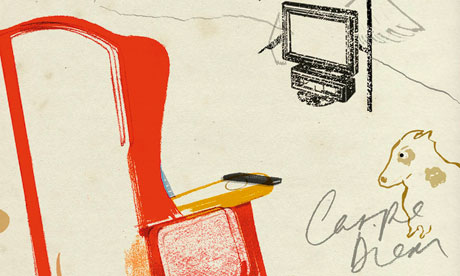
Are you sitting comfortably? Then get up, because sitting is killing you. Or that, at any rate, was the conclusion of two studies widely reported a few weeks back: one suggested that, after the age of 25, every hour spent sitting watching TV knocks almost 22 minutes off your life – twice the impact of one cigarette. The other found that the average adult spends 50-70% of the day sitting down, with the most sedentary among us at vastly greater risk of disease and early death. Across the world, I'm guessing, people saw this news and leapt from their chairs, determined to take the first of many bracing walks – before becoming distracted by something on TV and flopping absent-mindedly back down, like a dead-eyed crystal meth addict lured back to his destruction. Except with a sofa, instead of crystal meth. I'm aware this analogy may need some work, but I trust you see my point.
Fashionable solutions to the sitting epidemic, in the context of work, include standing desks (one of Donald Rumsfeld's favourite things, along with reckless military interventions) and treadmill desks (great, so long as you don't mind the sweat-flecked keyboard). But I solved the problem differently, by accident, while trying to solve another. As a feckless work-from-home type, I decided it was time to make sure I was sitting with good posture, so I forked out £500 for a widely recommended Norwegian ergonomic chair, the Håg Capisco. Its seat resembles a saddle, so instead of slouching, you perch. Or that's the idea; in reality, it's just rather uncomfortable. After 40 minutes, it's extremely uncomfortable – so I get up, stretch, go for a stroll, or squeeze out 30 push-ups, although technically I've never done the push-ups. Now I don't sit for too long, because it's simply no fun to do so. After a few weeks, I realised that something intriguing had happened: I'd switched my default state. Standing or strolling was now my automatic, baseline behaviour; sitting was something I actively "did".
This notion of adjusting your defaults turns out to be a surprisingly useful way to think about other kinds of habit change. It becomes easier to resist the siren call of the web and social media, for example, if you come to see "not being online" as the default state, and "being online" as the active, chosen one – something you sporadically choose to do, then stop doing. It's also the spirit behind the idea the productivity blogger Thanh Pham calls "clearing to neutral": the habit, after any activity, of clearing up the equipment involved – dirty pans, work files – so they're ready for next time. Gradually, tidiness becomes the default, mess the anomaly, and the good habit happens without thinking or effort. My latest experiment is a default bedtime of 10.30pm. I'm not sticking to it religiously, but that's not the point: it's what I revert to when there is no good reason to do otherwise.
This idea goes deeper: "adjusting your defaults" is one way that the meditation teacher Jon Kabat-Zinn defines the goal of mindfulness meditation. Being lost in thought is the default state for most of us; adjusting your defaults involves not ceasing to think, but rather making "present-moment awareness" the default, with thinking as the activity you choose to do when it's useful. He doesn't pretend this is easy. But it is a shift in perspective worth contemplating – preferably, of course, while standing up.
oliver.burkeman@theguardian.com
Follow Oliver Burkeman on Twitter

